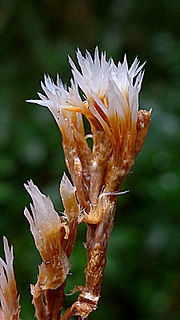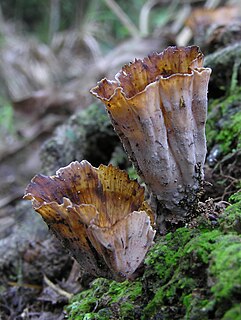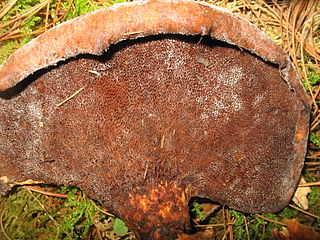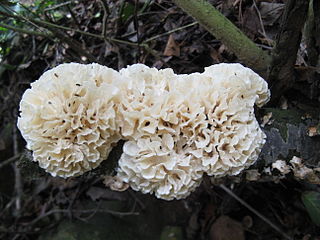
Cotylidia is a fungal genus characterized by small to moderately sized, white to palely yet brightly colored, stalked, fan-shaped to funnel-shaped fruit bodies with a smooth to wrinkled hymenium, tissues composed of monomitic hyphae, basidia producing smooth, nonamyloid spores, the absence of clamp connections, and bearing projecting cylindrical, thin-walled, hymenial cystidia. The genus is classified in the Hymenochaetales, however the type species, C. undulata has not yet been sequenced. Phylogenetically-related agaricoid fungi to the two species of Cotylidia thus far sequenced are in the genera Rickenella, Contumyces, Gyroflexus, Loreleia, Cantharellopsis and Blasiphalia, and Muscinupta and the clavarioid genus, Alloclavaria.

The Meruliaceae are a family of fungi in the order Polyporales. According to a 2008 estimate, the family contains 47 genera and 420 species. As of April 2018, Index Fungorum accepts 645 species in the family.

The Phanerochaetaceae are a family of mostly crust fungi in the order Polyporales.

The Lachnocladiaceae are a family of fungi in the order Russulales. A 2008 estimate places 124 species in 8 genera in the Lachnocladiaceae. Species of this family, which have a widespread distribution in both tropical and temperate zones, are typically found on decaying coniferous or deciduous wood. The family was circumscribed by British mycologist Derek Reid in 1965.

Podoscypha is a genus of fungi in the family Meruliaceae. The genus has a widespread distribution, especially in tropical regions, and contains about 35 species.

Cymatoderma is a widely distributed genus of poroid fungi in the family Meruliaceae.
Calathella is a genus of fungi in the mushroom family Marasmiaceae. According to the Dictionary of the Fungi, the genus contains nine species found in Europe and North America. The genus was circumscribed by the English mycologist Derek Reid in 1964.

{{Taxobox | image = Stereopsis humphreyi 56449.jpg | image_width = 240px | image_caption = Stereopsis humphreyi | regnum = Fungi | divisio = Basidiomycota | classis = Agaricomycetes | ordo = Stereopsidales | familia = Stereopsidaceae | familia_authority = Sjökvist, E.Larss., Pfeil & K.H.Larss. (2013) | genus = Stereopsis | genus_authority = D.A.Reid (1965) | type_species = Stereopsis radicans | type_species_authority = (Berk.) D.A.Reid (1965) | subdivision_ranks = Species | subdivision = }}

Dichomitus is a genus of poroid crust fungi in the family Polyporaceae. It was circumscribed by English mycologist Derek Reid in 1965.

Echinochaete is a genus of fungi in the family Polyporaceae. Circumscribed by English mycologist Derek Reid in 1963, the genus is widespread in tropical regions and contains five species.
Dichopleuropus is a fungal genus in the family Lachnocladiaceae. A monotypic genus, it contains the single species Dichopleuropus spathulatus, found in Malaysia. Dichopleuropus was circumscribed by English mycologist Derek Reid in 1965.
Derek Agutter Reid was an English mycologist.

Hydnopolyporus is a genus of two species of fungi. The genus was circumscribed in 1962 by English mycologist Derek Reid with H. fimbriatus as the type species.

Amanita ochrophylloides is a large mushroom of the genus Amanita native to southeastern Australia.

Saproamanita nauseosa is a species of agaric fungus in the family Amanitaceae. First described by English mycologist Elsie Maud Wakefield in 1918 as a species of Lepiota, it was named for its nauseating odor. The type specimen was found growing on soil in the Nepenthes greenhouse at Kew Gardens. Derek Reid transferred the species to Amanita in 1966, and then in 2016 the separate genus Saproamanita was created by Redhead et al. for saprophytic Amanitas and it was transferred to this new genus.












